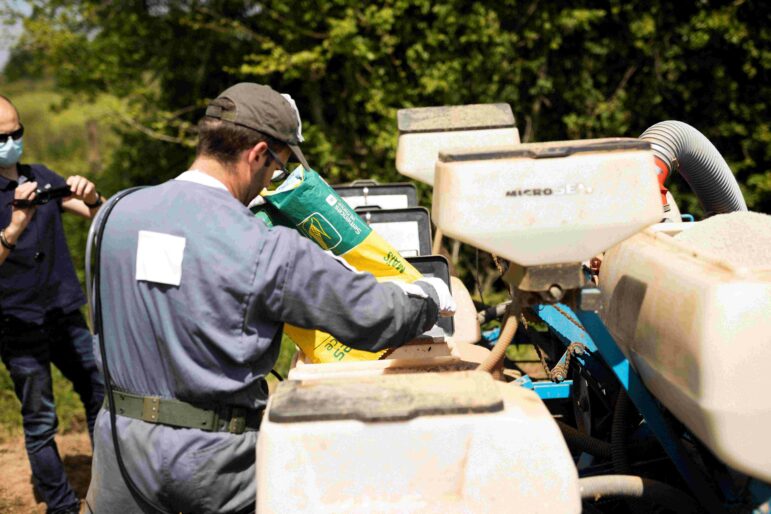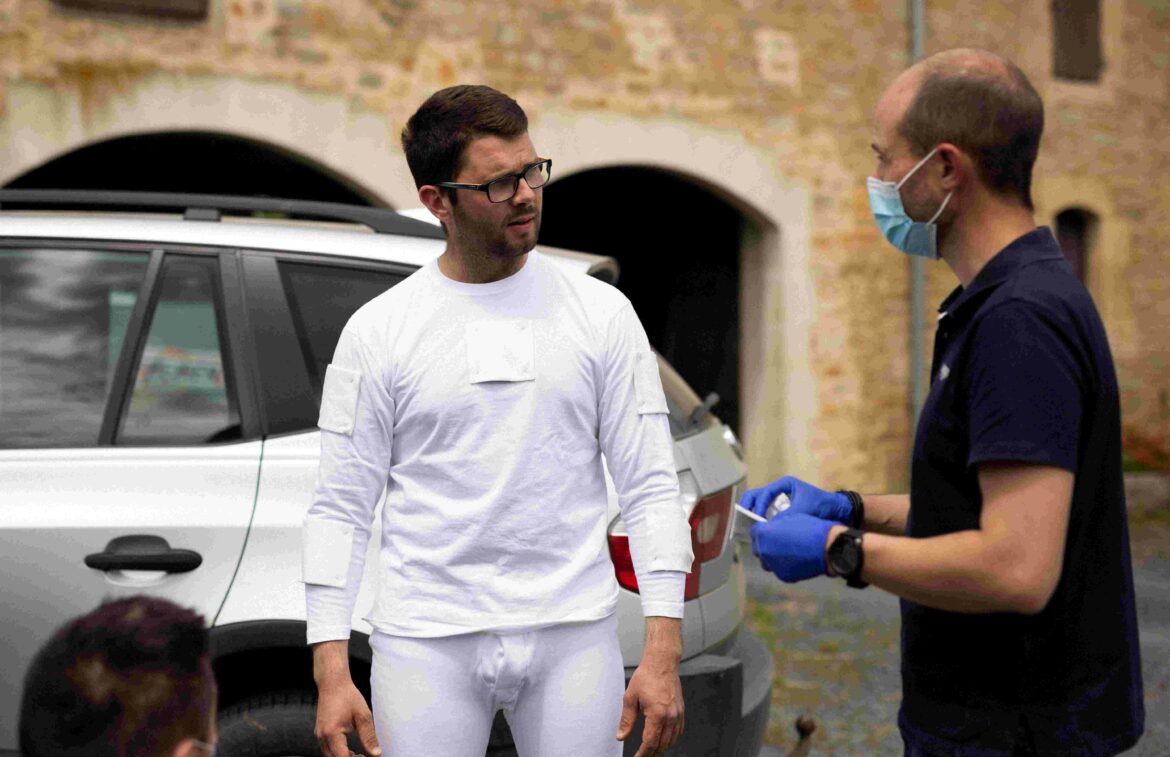
Edited and first published by EUobserver on 17th of February 2022.
Jean-Baptiste Lefoulon, a French farmer in Normandy, stands in boxer shorts in the middle of his farmyard. His stripped-down appearance is for a study called Pestexpo, for pesticide exposure, and its purpose is to observe the real-life work conditions of agricultural workers in field crops, greenhouses, apple orchards or vineyards.
Luis Grasa is a 70-year-old who worked all his life as a shepherd and farmer in Huesca, Spain. Eight years ago, Grasa was diagnosed with Parkinson’s disease, a progressive nervous system disorder that leads to shaking and difficulty with movement.
Dutch farmer John Hutten is another example. His parents had a farm, and he became a farmer himself. Now he has a slightly bent posture, his left arm does not swing while walking, and he is more tired than usual.
Grasa’s and Hutten’s stories are anecdotal. They do not prove cause and effect, but researchers seem them as two examples of possible connections to pesticides.
A disease on the rise
Bas Bloem, professor of neurology at the Radboud University Medical Center in the Netherlands, is a world-renowned expert on Parkinson’s and co-author of the recently published academic-paper The Emerging Evidence of a Parkinson Pandemic describing how the number of people with the disease doubled between 1990 and 2015 and is expected to double again by 2040.
“Parkinson’s is one of the few diseases that increases,” he said.
Bloem sees a clear link between pesticides and Parkinson’s disease despite the difficulties in pinpointing causality.
“The problem is that if you lose dopamine-producing cells, you get Parkinson’s disease” said Bloem. But that is “a process that can take many years.”
In June 2021, the world-renowned French research institute Inserm published a landmark report confirming that occupational exposure to pesticides was “strongly linked” to at least six serious illnesses.
Based on data from more than 5,300 scientific reports and studies, experts concluded that pesticides could cause Parkinson’s, cognitive disorders, non-Hodgkin’s lymphoma and multiple myeloma – both cancers that affect white blood cells – prostate cancer, as well as certain respiratory system disorders.
The report confirmed preliminary conclusions published by Inserm eight years earlier.
Now studies in the field
Meanwhile, in the Normandy fields and apple orchards, or the vineyards of Bordeaux, the Pestexpo team has demonstrated that farm workers are much more exposed to pesticides than previously thought.
And worse – the protection equipment simply doesn’t do the job. Perplexingly, in some cases, wearing coveralls or gloves might actually increase exposure.
“Farm workers are required to wear protective equipment but if they don’t, it’s their fault”, says researcher Isabelle Baldi. “And this is unacceptable because it means that we are rejecting a collective responsibility that starts from the moment a substance is put on the market.”
Alain Garrigou, professor of ergonomics at the University of Bordeaux, found data showing that pesticides can pass through plastic at the intramolecular level – not only because of holes, tears, or seams in the clothing.
“Pesticides have an exceptional penetration capacity,” said Garrigou. “They are peculiar chemicals that are made to kill, but above all they are made to penetrate plant and animal cells.”
This phenomenon is called permeation. “There is no such thing as dedicated pesticide protection clothing,” said Garrigou.
Fifteen years ago, Garrigou and Baldi detailed their findings and worries in an “alert note”.
But at the EU-level it took another seven years for the European Food Safety Authority (EFSA), responsible for the assessment of risks linked to pesticides, to develop a new mathematical model for the prediction of operators’ and workers’ exposure.
That, however, is still based on confidential industry data and doesn’t take into account the French findings.
An ’emotive stance’
EFSA acknowledges in its 2014 guidance, updated in 2022, that data is missing on many routine situations such as cleaning equipment and spraying in greenhouses.
Another apparent oversight was the Pestexpo studies: they were not mentioned, nor was the term permeation.
“The EFSA Guidance is based on well-conducted and validated experimental data,” wrote EFSA in an email to this team of reporters. It “is acknowledged that there is a high public concern about exposure to pesticides,” the authority wrote.
French researchers published a scientific review of the guidance on the assessment of exposure of operators, workers, residents and bystanders in risk assessment for plant-protection products in late 2019.
But that was countered by the pesticides industry through its organisation CropLife Europe (formerly known as the European Crop Protection Association, ECPA).
In a letter to the journal Safety Science, the lobby group said the researchers had taken “an emotive stance” that was “overstated at best and misleading at worst.”
CropLife Europe, declined an interview, but said in a written statement to Le Monde and EUobserver: “We did not feel that it presented a balanced view, exaggerated the health risks for operators and over-emphasised reliance on assigned protection factors in the registration of pesticide products.”
No data, no problem
And so, as of today, only France and Italy regard Parkinson’s disease as a possible direct consequence of working in the field and recognise it as an occupational disease.
But in Italy, only 10 out of 20 farm workers who requested it have received compensation for being ill with Parkinson’s between 2016 and 2020. In France only 278 patients have received compensation. In Germany an advisory board has discussed the issue for 12 years, but without reaching a conclusion.
In Poland, the 2.3 million people employed in agriculture lead a healthy life – if official registers are to be trusted.
Infections from tick bites account for 80 percent of compensation paid out to a total of 2,579 farm-worker cases. But there’s been no compensation for illnesses linked to pesticides.
In Denmark the trade union 3F, which organises farmworkers, said they had never heard of illnesses caused by pesticides. In Sweden just three cases of compensation due to pesticides was paid out in the past five years.
While the active substances in pesticides are authorised at a European level, the commercial products themselves are approved by national authorities.
To our knowledge no pesticide commercial product has been denied access to the market based on the findings in the French scientific reports.
In the EU, there is no treaty article to support legislation regarding workers’ health per se, and there are not even common rules on how these topics should be defined.
Eurostat, the EU’s office of statistics, has created an experimental database on occupational disease. But not all member states take part. It mostly illustrates how difficult it is to compare the situation in member countries.
The European Agency for Safety and Health at work (EU-OSHA) is not able to provide information on national legislation or standards.
“At the moment, not even basic statistics are comparable across member countries,” EU-OSHA press office said in an email.
One existing tool at the EU level is the European schedule of occupational diseases. It is a recommendation to member states to compensate workers for diseases from a specific list.
Asked about the correlation between pesticides and Parkinson’s disease in 2017, the then acting commissioner for health and food safety, Vytenis Andriukaitis, told the European Parliament that there was “no clear scientific evidence about [the] occupational origin of Parkinson’s disease.”
The commission’s position hasn’t changed since, spokesperson Veerle Nuyts indicated by email. Hence Parkinson’s disease does not appear on that list.
Making the victims responsible?
The EU nonetheless has an official “vision zero” approach to eliminating work-related deaths and a framework strategy for health and safety at work, adopted in June 2021.
“As one of these actions, the commission calls on member states to provide training to farmers (…) to increase their skills and awareness on the health and safety rules on farms, including safe use of chemical substances, in particular plant protection products,” spokesperson Nuyts said by email.
So, should farm workers then be primarily responsible for their own safety?
Catherine Laurent, director of research at the French National Research Institute for Agriculture, Food and Environment (INRAE), says no.
“Giving appropriate instructions to the workers comes only as the ninth possible measure,” Laurent says referring to an EU-directive from 1989 aimed at encouraging safety and health at work.
For ergonomist Alain Garrigou, the pesticide authorisation system is a “form of externalisation of the responsibility on the people who are its victims”.
Sociologist Jean-Noël Jouzel, director of research at the French National Centre for Scientific Research CNRS, is the author of Pesticides: How to Ignore What We Know. He says the “safe use” of pesticides is pure “fiction”.
When EFSA was asked by us if they would comment on Jouzel’s claim, the EFSA came back with a two-letter-word answer:
“No.”
